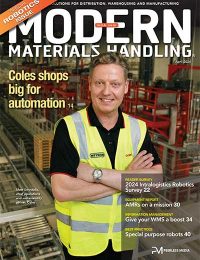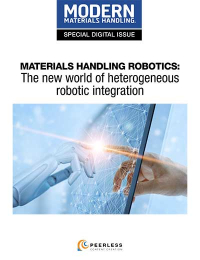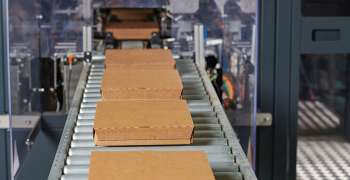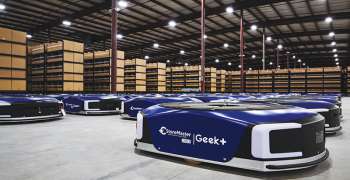It’s still all about the software – MHLC Day 2
We may be on the cusp of the next generation of warehouse software
Latest Material Handling News
Two voices of reason on pallet materials 60 Seconds with Bob Trebilcock, outgoing executive editor, Modern Materials Handling Learn from lift truck service history The reBound Podcast: How Pitney-Bowes is innovating with autonomous vehicles. Packaging Corner: Be open to change More BlogsThe materials handling industry has been undergoing a transition from a focus on hardware – speeds and feeds – to an emphasis on the software that the directs the equipment for some time. The transition has been driven by a couple of factors, in my view.
One is physics: No matter how good the motors, drives and gear systems, there’s a limit to the speed at which conveyors, sorters and automated storage systems can safely operate. Software, on the other hand, allows those systems to be more efficient and effective at normal speeds. Sorters, for instance, can sort with less gap space between cartons and parcel packages..
Another is managing complexity: There are just too many SKUs, too many value-added services and too many variations in orders – too many decisions - for people to manage.
The last is the emergence of maintenance as a best practice in warehousing. MRO, and MRO-related software, are long established in manufacturing, where the uptime of automated manufacturing systems is critical. We’re now experiencing that same criticality in warehousing and distribution.
The common denominator in all three examples is the need to operate smart rather than just fast. That’s software.
Based on a conversation I had the other day as part of Day 2 of this year’s MHLC with Hamid R. Montazeri, Dematic’s senior vice president of software and digital solutions development, I think we’re on the cusp of the next generation of warehouse software. This is a case where on-premises and cloud software work together to get the job done. More on this in a minute.
Montazeri and I began talking in general about some of the things he’s seeing at Dematic, as a result of talking to customers as well as his own product managers. The topic here was maintenance software. In that space, a lot of the talk is about predictive maintenance. That’s the ability of equipment management system being able to predict a maintenance event in advance of a breakdown based on real-time operating systems. When we get there, maintenance organizations will be able to move away from performing maintenance at prescribed times to more pinpoint servicing of equipment.
That’s where we are going, but that’s not where we are yet. The first step is to put sensors on various parts of a system – either new equipment going out the door or retrofitted onto existing systems – to gather IoT data. That data, in turn, can go to a data lake where it can be analyzed by machine learning algorithms to do the predictive analysis.
Predictive analytics requires data, and lots of it. “The world of predictive maintenance is 10% algorithms and 90% data,” Montazeri said. “That kind of detailed data isn’t commonly available right now in intralogistics.” To get there, he noted, we first have to get more sensors on our systems. That’s happening now, primarily with newly installed equipment. But it’ll still be some time before we’ve collected enough data, and have enough history, to make meaningful predictions. In the interim, there is real-time condition monitoring, which Dematic is doing now.
Montazeri described that as “a stepping-stone to get to predictive maintenance.” He added: “If you have real-time data, you can compare the signals coming off your equipment to see if they are outside normal characteristics, which alerts you to a potential problem. We can provide that to our customers now, based on real-time and limited data.”
From there, we talked about what Montazeri called an emerging architecture that “combines the world of Cloud and on premises software.” Rather than an either/or situation – your software is either on premises or in the cloud – it’s a hybrid approach that combines Edge computing – or what Montazeri called the Intelligent Edge that puts computing power on premises where the work is being done and there is no room for latency – and Cloud computing – where you can harness storage for data lakes and computing power to crunch a lot of numbers.
“When you take computing to the cloud, there’s a latency added to the time it takes for an equipment action given the time associated with transmission of signals,” Montazeri said. “We’re getting to a point, however, where you can do a lot of calculations cheaply onsite, which is the Intelligent Edge, and combine that with the storage and computing power you have in the Cloud. It can also open the door for creating a software eco-system.”
Montazeri believes this combination could be a transformative step for intralogistics software. It is certainly a different way to think of software systems inside warehouses and distribution centers, and may point the way to the next generation of solutions.

Article Topics
Blogs News & Resources
Two voices of reason on pallet materials 60 Seconds with Bob Trebilcock, outgoing executive editor, Modern Materials Handling Learn from lift truck service history The reBound Podcast: How Pitney-Bowes is innovating with autonomous vehicles. Packaging Corner: Be open to change 60 Seconds with Robert Martichenko of American Logistics Aid Network The reBound Podcast: Looking for talent in all the right places: How Essendant is revolutionizing recruitment More BlogsLatest in Materials Handling
Beckhoff USA opens new office in Austin, Texas Manhattan Associates selects TeamViewer as partner for warehouse vision picking ASME Foundation wins grant for technical workforce development The (Not So) Secret Weapons: How Key Cabinets and Asset Management Lockers Are Changing Supply Chain Operations MODEX C-Suite Interview with Harold Vanasse: The perfect blend of automation and sustainability Consultant and industry leader John M. Hill passes on at age 86 Registration open for Pack Expo International 2024 More Materials HandlingAbout the Author
Subscribe to Materials Handling Magazine

Find out what the world's most innovative companies are doing to improve productivity in their plants and distribution centers.
Start your FREE subscription today.
April 2024 Modern Materials Handling

Latest Resources










